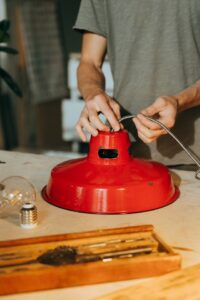Outdoor lighting can dramatically improve the look, safety, and enjoyment of your home’s exterior spaces. Whether you want to install path lights along walkways, up-lights for trees, or accent lights for architectural features, proper installation is key. This guide will walk through the full process of how to install outdoor lighting yourself.
5 Factors to Consider When Choosing the Right Outdoor Lights

Before installing outdoor lights, it is essential to choose the right ones for your property whether you install them yourself or a reputable outdoor lighting company. Here are several key factors to consider when selecting outdoor lighting to ensure it meets your needs and preferences:
Purpose
Determine the main intent behind your outdoor lighting installation – security, ambiance, accent lighting for trees/architectural features, pathway illumination with path lights, etc. This will guide which light fixture types and brightness levels you need.
Installation Type
Decide if you want solar-powered lights, low-voltage landscape lighting wire, or line-voltage electrical wiring and fixtures. Low-voltage is easier for DIY install but line voltage provides more brightness if hiring a licensed electrician. Consider adding an electrical box or outdoor outlet.
Lighting Needs
Evaluate the areas around your home’s exterior that require outdoor lights, such as walkways, entrances, landscaping beds, walls, yard signage, etc. Map out the ideal cable route and locations.
Style/Aesthetic

Choose outdoor lighting designs, fixture finishes, and bulb colors that aesthetically complement your home’s exterior architectural style and color scheme for a cohesive look. Blend with vinyl siding, stucco, or other materials.
Budget
Set a realistic budget that accounts for upfront costs of light fixtures, possible electrical work like running underground feeder cables, tools for wiring, plus long-term utility and maintenance expenses.
Planning Your Outdoor Lighting Layout
Before installing any light fixtures, take time to plan your outdoor lighting setup carefully. Walk around your yard and consider what areas need illumination and what purposes the lighting should serve – such as security, ambiance, accent, wayfinding, etc. Decide if you want solar-powered lights or hard-wired electrical fixtures.
For electrical outdoor lighting systems, map out the cable route from the planned power source (typically an outdoor electrical box or house circuit) to each fixture location. Make note of any potential obstacles like trees, pipes, or other underground utility lines to avoid damaging them when burying the landscape lighting wire.
Be sure to call local utility companies beforehand to have any existing underground lines properly marked. This prevents accidentally striking cables, wires, or pipes when you begin digging.
Prepare Outdoor Lighting Installation Supplies: Light Fixtures, Wires and Tools
Gather all tools and materials needed before starting your outdoor lighting installation:

- Outdoor light fixtures (path lights, spotlights, floodlights, etc.)
- Landscape lighting wire (gauge based on project size)
- Wire strippers/cutters
- Utility knife
- Bright spray paint
- Shovel or edger tool
- Outdoor electrical boxes with covers
- UF (underground feeder) cable if connecting to mainline
- Silicone caulk
- Voltage meter
- Screwdrivers (flathead and Phillips)
- Bulb replacements
If installing new outdoor lighting that needs to tie into your home’s electrical system, you may want to hire a licensed electrician or a company unless you have significant wiring expertise.
Step-by-Step Instructions for Installing Outdoor Lighting

By prioritizing the purpose, installation methods, required illumination coverage areas, aesthetic appeal, and overall costs, you can make optimal selections for an outdoor lighting plan tailored to your home’s needs and preferences. Next, you can proceed with installing outdoor lights and here are the steps to follow:
1. Plan Locations
Use bright spray paint or string to mark the exact locations where each outdoor light fixture will be installed along the planned cable route path. Consider placing path lights along walkways or driveways, up-lights to accent trees and architectural features, and floodlights for larger areas.
2. Dig Trenches
Using a shovel or edger tool, dig a shallow trench (around 6 inches deep) following the mapped-out cable route. This narrow trench is where the landscape lighting wire will be buried to connect each fixture. If running a new underground feeder cable from the home’s power source, dig a separate deeper trench (18-24 inches) for that main line.
3. Lay Main Line
If tapping into your house’s electrical system to power the outdoor lighting, start by running a new UF (underground feeder) cable buried within that deeper trench from the planned power source location to the first marked light fixture spot.
4. Lay Lighting Cable
Next, unroll the landscape lighting wire and carefully position it down inside the shallower cable trench you created, following the fully planned cable route path. Leave some slack (3-6 inches of extra wire looped) every 4-6 feet to allow for expansion.
5. Install Light Fixtures
At each marked location for a new outdoor light fixture:
- Dig out a hole or short trench segment that allows you to access and work with the lighting cable wires and mounting area for the fixture
- Use wire strippers to strip back the plastic casing on the cable end, exposing 6-8 inches of the inner wires
- If this fixture needs to connect to the main underground feeder line, splice into it using approved outdoor wire nuts and seal connections with outdoor silicone caulk
- Connect the light fixture’s wires to the corresponding wires of the landscape lighting cable using weatherproof wire nuts or clamps
- Use outdoor-rated silicone caulk to fully seal all wire connections to prevent moisture intrusion or corrosion
- Mount the light fixture securely according to manufacturer instructions at the desired height and angle, whether to a post, siding, wall, or in-ground housing
6. Bury Cable
Once all individual light fixtures are installed and wired along the full cable run route, carefully re-bury the landscape lighting cable by refilling the cable trench. Compact soil and use a hard tool to indicate cable location if desired.
7. Install Junction Boxes
At the power source connection point as well as any locations where cables were spliced into each other, install outdoor-rated electrical junction boxes following local codes. These plastic, metal or composite boxes will safely enclose connections.
8. Make Connections
Inside the approved outdoor junction boxes, make any remaining cable splices as needed using outdoor wire nuts and apply silicone caulk over all connections for weatherproof protection. If this location connects to the home’s main electrical line, properly attach the UF feeder and all grounding wires per the electrical code. Install safety covers once finished.
9. Circuit Testing
With all outdoor lights and wiring now completely installed, turn on the circuit breaker to energize the system. Carefully test that every light fixture is working properly by observing if it’s illuminated. Use a non-contact voltage meter or tester to confirm power at any boxes or exposed wires.
10. Final Adjustments
Make any final adjustments to pivot or angle the light bulbs to achieve your desired lighting coverage and effects. Install bulbs if not pre-installed in fixtures. Add accessories like light switches, dimmers, decorative signs/numbers, or complementary landscaping.
The Bottomline
Your outdoor lighting system is now fully installed and operational! Flip the switch to illuminate your home’s exterior and garden spaces. For larger projects or anything beyond basic electrical skills, consider hiring a professional licensed electrician. Companies like Plano Outdoor Lighting Co. offer convenient full-service installation if you prefer to skip the DIY work.
Always follow proper safety procedures like shutting off power at circuit breakers before working with any electrical wiring. Double-check that all connections are properly enclosed and sealed against moisture by using the right waterproof materials. Use only products rated for direct burial and outdoor use.
Enjoy the new lighting and the beauty, safety, and functionality it adds to your outdoor living spaces day and night! Quality outdoor lighting can truly transform a home’s exterior.
